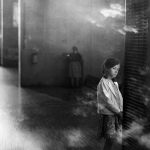The paradoxical expression “to believe in science” can lead us to induce that for many people, especially those who revere the reason above all forms of knowledge, science is a religion. In that case, the museum would have with no doubt the role of the cathedral. In that sense, and to gild the lily, modern science museums would represent the main stronghold in the constellation of museums.
If museums symbolize today’s cathedrals, the National Art Museu of Catalunya (MNAC) in Barcelona not only shares with other museums the ritualization of culture but it literally houses parts from Romanesque churches inside. I am referring to the wall paintings.
Where does the prayer end and the contemplation begin? When does contemplation fade and analysis start? The paintings have endured over time, but are no longer on holy ground… What impression are they giving us now when we look at them in a museum? We could assume that the XII century wall paintings enraptured the believer, they generated a mixture of the fascination and respect of the sacred arts. Within a museum the image is rationalized, we see it filtered by the reason, we observe it and examine it. But also what captivates us is its majesty, its beauty, its universality … its art. Where does the sense of transcendence, the devotion, or the intellectual pleasure come from? Perhaps there is a common place where emotions emerge… Aren’t the emotions the stimuli that feed both faith and knowledge?
The light, size and peacefullness of a museum are similar to those experienced in churches. Even our behavior is similar in both spaces. Perhaps the most notable change of this transit from the church to the museum is shown in our way of looking at the paintings. My working hypothesis here is simple: there has been a rationalization of feelings in our perception of the artworks.
(Photographs made in Barcelona in 2011 and edited in 2015).





